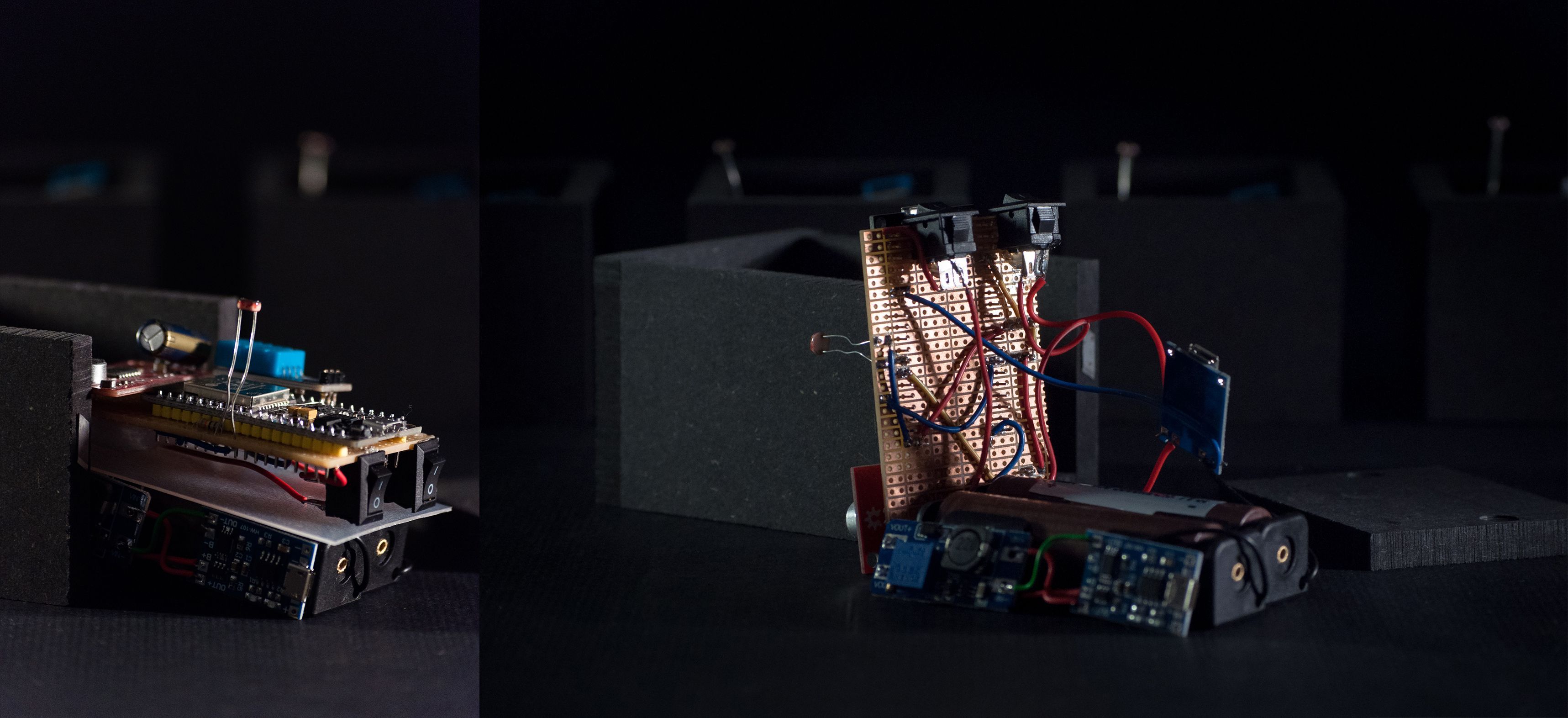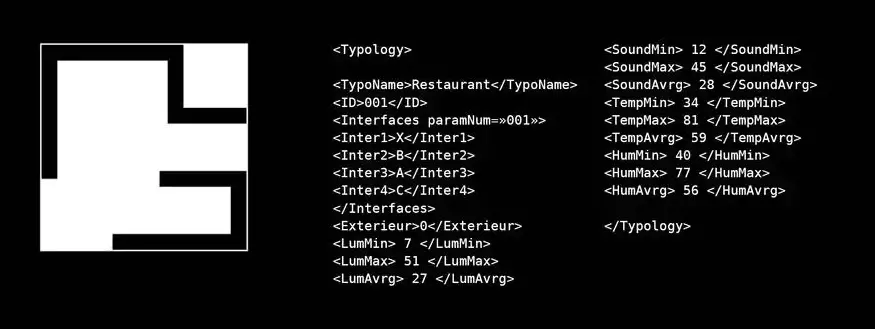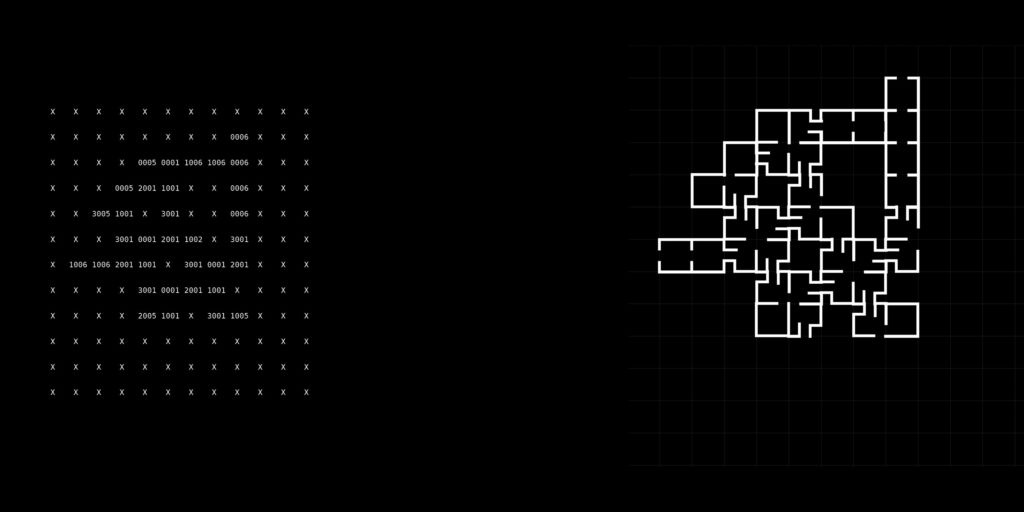ENSAPM . Master Thesis . Tutors: Frank Minnaert , Emmanuelle Chiappone-Piriou . 2018-2019

Introduction
The ambition of this end-of studies project was to set up a personal design process synthesising, as part of a coherent whole, a singular way of considering and act on reality. This conception of things, influenced by the understanding of computer systems for data production and processing , gives rise to the creation of a set of instruments that allow us to see and manipulate the different layers of abstraction in the world.
Due to the use of formal languages induced as well as the nature of the material handled, a computational design process is achieved through a certain logical division. The latter is then conceived as an attempt to rationalise an object considered as complex: the real.
The results, whatever their nature, contain in their final-end product the expression of the choices made throughout the development process.
We identified three steps in a computational design process, to be detailed at a later stage. Each of these steps involves the design of a series of instruments mobilising several programming languages (C#/.NET Framework, Arduino (C/C++), Processing (Java), Grasshopper, Max MSP, Node Red, etc.). The use of these languages makes it possible to control and understand the logical articulations internal to any production.

Step 1: From physical environment to data
The first step of this project consists in capturing data in three selected locations. This is made possible by the development of five measuring boxes which, over the course of a day, collect data on light, humidity, temperature and sound levels parameters.
Choices made at this stage are crucial and influence the whole project development. The architect must then ask himself the following questions: what do I want to extract from reality and to what end? By what means? How do I communicate about it?
It is possible to group the choices made in two categories: on the one hand the definition of modules, and then, on the other hand, a more operational aspect: number of components, placing in space, frequency of capture, etc. These two moments are to be considered as opportunity for the designer to specify the bases on which he will develop his intervention within the physical world.

Step 2: From raw data to structured information
The tens of thousands of data captured during the previous stage did not allow an apprehension of the captured qualities. We therefore tried to reduce the amount of data in order to understand it and, above all, to bring out the meaning necessary for any subsequent manipulation. We consequently set up a series of tools allowing the visualisation of these data, in order to interpret their qualities.
It is therefore the choices we make that allow us to structure a specific reading of the captured phenomena. These choices are of several natures, and relate to the choice of the parameters to be correlated, as well as to the chosen modes of representation. A fixed set of data can result in a multiplicity of readings. Our goal is to be able to describe a place according to the quantities it contains. Quality is therefore extracted from quantity.
Each visualisation system is an opportunity to abstract the space further, to define an imprint of it, reading of which reveals specificity: evolution of values over time, variations in intensity, exposure/manifestation of contrasts between and within spaces.
Exemple with the capture of 1 space
Spatialisation through discretisation
La difficulté tout comme l’intérêt de cet exercice viennent de la réduction des dimensions intrinsèque aux espaces mesurés. Il est possible de rapprocher cette démarche avec la notion de compression évoquée par Gregory Chaitin. Il est en effet possible, selon lui, de définir la compréhension d’un phénomène comme notre capacité à en réduire l’information présente. Cet aspect réductionniste n’est donc pas à considérer sous l’angle de ce qui est perdu, mais comme une manière de rendre explicite la compréhension que nous avons de cet espace.

Vp = (VA1*d1+VA2*d2+VA3*d3) / (d1+d2+d3)

Intensity Variations
Comparison of 3 spaces
Step 3: Manipulation from information
The work of abstraction carried out during the second phase aimed to qualify a place. We then tried to make up one. To do so, we considered each of the previously dissected spaces as a component. This unit, made of several dimensions, is part of a set, similar to a material, that can be manipulated through the quantified qualities it contains. These ‘particles’ emerge as typologies containing several semantic layers: maximum, minimum, average, contrast, temperature, sound, etc… The whole is contained in a set of text (XML) files. The aggregates presented are the result of a proliferating algorithm. With each iteration, the program analyses the quantities present in the discretised space and compares it to the goals defined beforehand by the user (e.g.: maximising light contrasts, minimising sound volume, etc.).
The third and last step in our design process combines the synthesis of the axiomatic frameworks defined as above and opens to future developments. The previous stages have enabled a definition and formalisation of our relationship to space. While they may have been quite analytical, they have nevertheless given way to the emergence of new properties, which we will consider as constitutive to the notion of quality.



References
Object oriented and systems theory:
ALLEN, Stan. « From Object to Field ». In Architecture after geometry, 24‑31. Architectural design Profile, 67,5/6 127. London: Acad. Ed, 1997.
ALIZART, Mark. Informatique céleste. Paris : Presses universitaires de France, 2017.
ARBRESMAN Samuel, « Overcomplicated: Technology at the Limits of Comprehension », Current, 2016
BRATTON, Benjamin H. The Stack: On Software and Sovereignty. Software Studies. Cambridge, Massachusetts London: The MIT Press, 2015.
BREHIN, Yannick. Éléments Pour Une Approche Formaliste de La Production Artistique « Contemporaine ». Marges, no. 01, 2003
CAPELL ZAPATA, Ferran, et GUENAND, Anne, Une ontologie de la sémantique de l’objet, Université de Technologie de Compiègne, 10e Séminaire CONFERE, 2003
CLAEYS, Damien. Architecture & complexité : un modèle systémique du processus de (co)conception qui vise l’architecture, 2013.
HARMAN Graham, L’Objet Quadruple une métaphysique des choses après Heidegger, Presses Universitaires de France, 2010, France
KÖHLER, Daniel. The Mereological City: A Reading of the Works of Ludwig Hilberseimer. Édité par Architecture, volume 36. Bielefeld : transcript, 2016.
KROB Daniel, Ingénierie des systèmes, (Conférence) Séminaire MINnd n.11, 2016, France
MEILLASSOUX, Quentin, Après la finitude : essai sur la nécessité de la contingence. L’Ordre philosophique. Paris : Seuil, 2006.
QUARANTE, Danielle, et Guy Denielou. Eléments de design industriel. Paris : Polytechnica : Diff. Economica, 2001.
RIOUT, Denys, Art Abstrait – Abstraction et Formalisme (ch.), Encyclopédie Universalis 2015
SATTLER, Léa. L’ère post-BIM – pour une obsolescence déprogrammée, 2015, Digital Knowledge
VON BERTALANFFY Ludwig, The Meaning of General System Theory, dans Computational Design Thinking, Wiley, 2011, UK
VON BERTALANFFY Ludwig, General System Theory: Foundations, Development, Applications, 1969
WISCOMBE Tom, Harman Graham, Gannon Todd, Ruy David, The Object Turn: A Conversation, dans Log n.33, Anyone Corporation, 2015, USA
Building with information:
LONGO, Giuseppe, Nabil Zakhama. « Le modèle comme regard organisateur du réel ». In Naturaliser l’Architecture. HYX, France, 2013.
MAAS, Winy, et MVRDV (Firm), éd. Metacity datatown. Rotterdam : MVRDV/010 Publishers, 1999.
SALANSKIS, Jean-Michel. Le monde du computationnel. Paris : Éd. les Belles lettres, 2011.
Tufte, Edward R. Envisioning Information. 1st edition edition. Cheshire, Conn: Graphics Press, 1990.
NEUMANN, John von, «The Computer and the Brain». 3 edition. New Haven, Conn. ; London : Yale University Press, 2012.
TRICLOT, Mathieu. « Le moment cybernétique : La constitution de la notion d’information ». Seyssel : Champ Vallon Editions, 2008.
Generation / Emergence:
FRAZER, John, An Evolutionary Architecture, AA Publications, 1995, UK
SOLOMOS, Makis. “Notes Sur La Notion d’ ”émergence” et Sur Agostino Di Scipio.” In Manières de Faire Des Sons, edited by Horacio Vaggione (éd.) Antonia Soulez, 83–100. L’Harmattan, 2010
VARENNE Franck, « Le parti-pris des choses computationnelles », 2012 in «ArchiLab : Naturaliser l’Architecture» HYX, 2013.
VARENNE Franck, «La reconstruction phénoménologique par simulation : vers une épaisseur du simulat», in D. Parrochia & V. Tirloni, « Formes, systèmes et milieux techniques après Simondon », Lyon, Jacques André Editeur, 2012
WOLFRAM, Stephen. 2002. A New Kind of Science. 1. ed., 4. print. Champaign, Ill: Wolfram Media.
Granular approach:
SOLOMOS, Makis (dir), Iannis Xenakis, La Musique Electroacoustique, Editions L’Harmattan, 2015, France
ROCHA Iturbide Manuel Les Techniques Granulaires dans la Synthèse Sonore (Thèse), Université Paris VIII, 1999
DOURSAT René, SAYAMA Hiroki, MICHE Olivier, A review of morphogenetic engineering, Springer, 2013
DIERICHS, Karola et MENGES, Achim. « Granular Morphologies: Programming Material Behaviour with Designed Aggregates». Architectural Design 85, n. 5 (septembre 2015): 86‑91.
DIERICHS, Karola et MENGES, Achim. « Aggregate Structures: Material and Machine Computation of Designed Granular Substances ». Architectural Design 82, n. 2 (mars 2012): 74‑81.
Autonomy and context:
KAUFMANN, Emil, De Ledoux à Le Corbusier : Origine et développement de l’architecture autonome, Editions de la Villette / traduction de Von Ledoux bis Le Corbusier : Ursprung und Entwicklung der Autonomen Architektur, 1933.
CACHE Bernard, Terre Meuble, HYX, 1997, France
KOOLHAAS Rem, S, M, L, XL, The Monacelli Press, 1995, New-York
SHANE David Grahame, « Meta City: Origins and Implications », in Antonella Contin, Paolo Paolini et Rossella Salerno (dirs.), Innovative Technologies in Urban Mapping, Cham, Springer International Publishing, 2014, vol.10, pp. 59‑72.
FOUCAULT Michel, « Les Hétérotopies », retranscription, France-Culture, 1966





